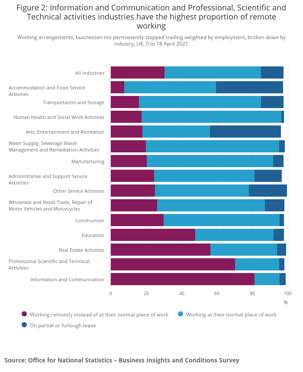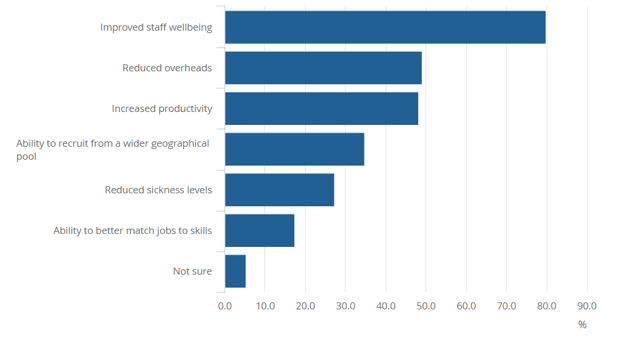7 benefits of hybrid working for your organisation
By Tara Clarke in Hybrid Working
The outbreak of COVID-19 in early 2020 saw a seismic shift in the way the world went to work. And in the months since things have begun returning to ‘normal’, there’s been a surge in interest around the concept of hybrid working.

Search trend data for the term ‘hybrid working’
Hybrid represents a healthy middle ground between traditional work models and working from home.
In fact, according to the ONS, working from home fell from 22% to 14% between February and May 2022, while hybrid rose from 13% to 24% in the same period. This suggests that businesses are more receptive to the middle ground.
But a lot of employers - and their employees - still have questions about what hybrid working is, and the potential advantages it offers.
In this blog post we’ll round up 7 benefits of hybrid working to demonstrate the value it could bring to your organisation, as well as 3 potential drawbacks to be aware of.
The advantages of hybrid working
Let’s start with the good stuff: a handful of potential benefits that hybrid can bring to your business.
1. Work life balance
Some of us thrive in an office environment, but a great deal of people gain a lot from working in their own space at least part of the time. Hybrid working offers employees the best of both worlds: they’re present in the office when they need to be, and can work in a more personal environment when workload allows.
2. Lower risk of isolation
With fully-remote working, some employees find the complete lack of contact to be isolating and counterproductive. Only ever interacting with your colleagues via video call or instant message isn’t the same as sitting down and having a face-to-face meeting, or even just chatting over a coffee in the kitchen.
Hybrid working allows conversation and ideas to flow in both digital and face to face contexts.
3. Office space is cheaper
A company using the hybrid working model won’t require as much office space, especially if they use staff location tracking to manage capacity ahead of time. In a time of increased economic uncertainty, having the option to downsize and reduce company overheads is perhaps the most appealing benefit of hybrid working.
4. Employees save money, too
Each day someone works from home, they save a handful of pounds on commuting costs - whether that’s a bus fare, a train ticket, or a few litres of petrol. Add these costs up over the month and it equates to a considerable saving, hopefully further contributing to employee morale and peace of mind.
5. Less employee downtime
When an employee has a contagious illness, the worst case scenario is for them to come in and infect the whole office. But similarly, calling in sick with the sniffles isn’t ideal either. With hybrid working, employees can use their discretion to keep working from home when they’re not feeling 100%.
Combine this with remote leave & sickness management tools that allow employees to manage their leave requests from afar, and you’re left with full visibility.
6. Broader talent pool
Offering a hybrid work model means your organisation can recruit from further afield, potentially allowing you to tap into a much broader pool of talent. If an employee only needs to be in the office one day a week, they’re likely to be willing to travel a little further for that day.
This is another example of how hybrid working can give you a competitive edge over companies who are reluctant to make the switch. Add online onboarding to the mix and you can even onboard your new hires remotely, saving even more commute time.
7. It’s greener
Every avoided commute means a slightly reduced carbon footprint for your organisation, which in a time of ever-increasing awareness of climate change is a real boon for the planet, as well as your corporate social responsibility score.
The disadvantages of hybrid working
To keep things balanced and let you make an informed decision, here are a few potential drawbacks of a hybrid work model:
1. Keep an eye out for burnout
Left to their own devices, some employees will struggle to maintain the line between work and leisure at home. Over time this can lead to employee burnout, as they feel obliged to work all hours of the day.
Advanced performance management and goal management tools are a crucial part of hybrid working: both allow management to ensure employees have realistic, achievable workloads and that channels of communication are open to avoid burnout.
2. Scheduling can be trickier
Video calls are great, but sometimes it’s just easier to communicate and collaborate when you’re in the same room. But when it’s not guaranteed that your colleagues will be in the office, it can be tricky to book those meetings in.
Using staff location recording software is a great way to ensure that face to face meetings can be booked when needed.
3. Project visibility can be reduced
In a similar vein, if you’ve lots of people collaborating on a project from different locations, it can be hard to keep track of who’s done what and what’s left to be done. This is another situation where using the right tools can help: Appogee Time project tracking software is designed to track time against customers, projects and teams, to keep things moving.
Is hybrid working here to stay?
Deciding whether or not to move to a hybrid working model is a complex process. There are lots of factors to bear in mind, and their exact configuration will vary between organisations.
Wherever you currently stand, know that there are tools to help your organisation make the transition. Our HR and productivity software solutions are designed to meet the needs of your business, rather than trying to be one-size-fits-all.
To see whether Appogee HR is right for you, why not request a demo or try our software for free for 14 days.
.webp?height=168&name=appogeehr%20(1).webp)




